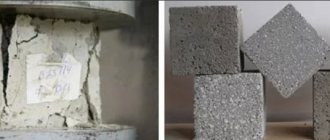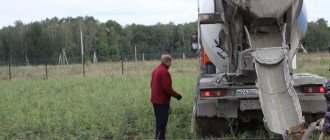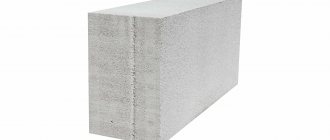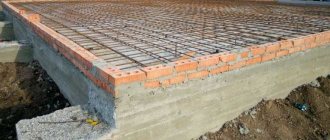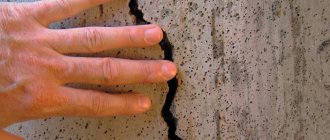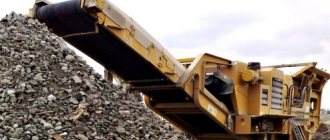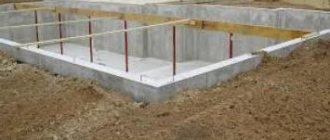In construction, one of the serious problems is the shrinkage of concrete during hardening. Since this wonderful material appeared, builders all over the world have been trying to reduce the rate of settlement of the cement composition. This depends on a number of factors.
Initially, the shrinkage of reinforced concrete occurs due to the loss of water; over time, the composition shrinks due to the physical and chemical processes occurring in it.
Photo of mechanical concrete pouring.
Existing types of shrinkage
If we go from the very beginning, then, first of all, it is worth mentioning the contraction compression of concrete.
- This type of compression occurs during the process of mixing the solution. Hydrates, which are formed as a result of the interaction of water with cement, have a smaller volume than the original material.
- This type of shrinkage has a greater effect on the porosity of the composition than on its volume. More significant volume losses occur with dehydration.
Dehydration of the solution
Dehydration or wet shrinkage of reinforced concrete exceeds contraction values by 7–12 times. Experts divide it into 2 stages.
The first stage is conventionally called plastic, the second hydraulic.
- The processes of plastic settling of the solution take place intensively within 3–6 hours after pouring. This is caused by active loss of moisture during evaporation; a large percentage is taken over by the formwork and base. The less water in the composition, the lower the shrinkage rate. Also, a product with good reinforcement loses less volume.
- After the solution has set, plastic deposition smoothly turns into hydraulic deposition. It does not happen so quickly and intensely, but given the volume of the foundation it can be much more dangerous. Concrete dries unevenly, causing the cement stone to also shrink unevenly. This results in internal stresses that can lead to cracks.
Crack due to settling.
Important: if pouring is carried out at high temperatures in a hot climate, then due to a lack of water, cracks may form already at the first, plastic stage of settling the solution.
- For 1 m of pouring, the total settlement of the solution can reach 3 - 5 mm. At first glance, it may seem that the numbers are not significant, but when converted to the volume of a large construction project, the losses can be quite serious.
Product strength control.
Losses during operation
After the concrete solution has completely hardened, the settling processes in it do not stop. It’s not for nothing that experts recommend letting the foundation stand before starting construction.
Depending on the quality of the cement, the settling time of the foundation can range from six months to 2 years.
- As a result of carbonization, under the influence of carbon dioxide in the atmosphere, as well as due to seasonal temperature changes, concrete products can lose up to 5 mm.
- It is for this reason that foundations are poured in the spring or in the first half of summer, so that the concrete dries as best as possible before frost and does not tear it in winter.
Filling the solution along the gutter.
Methods to eliminate or reduce shrinkage
So how can you influence this property and prevent the structure from being destroyed or defective? There are a number of methods:
- high-quality control of the composition of the concrete mixture (the presence of dense aggregates and a decrease in the amount of porous aggregates reduces the possibility of concrete shrinkage)
- quantitative control of the composition (the more aggregates and less cement stone, the less shrinkage)
- the use of alite-type cements (affect the chemical interaction of cement and water, reducing shrinkage)
However, there is a point regarding the qualitative composition of aggregates that needs to be taken into account. If shrinkage stresses are likely to occur, it is advisable to use porous aggregates to maintain the integrity of the cement stone and avoid cracks. Nowadays, special compositions of cements are also used, which, when reacting with water, begin to expand, thereby compensating for compaction, reducing volume and minimizing shrinkage.
Nuances of shrinkage in different conditions
Vibration work
This method is the most common and has been used for more than 100 years. Its essence is to squeeze out excess air from the solution as best as possible. In the specialized literature, such actions may be called compaction of the concrete mass.
You can operate manually or using technical means.
- Do-it-yourself compaction is done using improvised means, by repeatedly punching, bayoneting and compacting the total mass of the solution . It can be quite effective, but it requires qualifications and significant labor costs.
- When using vibrating machines, qualifications are no longer so important, the quality of work also increases many times , the only significant disadvantage here is the high price of the vibrating machine itself.
Deep vibrator.
The video in this article shows pouring the solution and working with a deep vibrator.
Important: the shrinkage coefficient of concrete during vibration ranges from 0.8 to 0.6%. This allows the use of much drier mixtures and mixtures with increased rigidity. Concrete shrinkage in percentage is regulated by GOST 24544-81.
- After vibration laying of the screed over large areas, so that it does not crack due to internal stresses and deformations, reinforced concrete is cut with diamond wheels. To compensate for stress when pouring volumetric foundations, diamond drilling of holes in concrete is used.
The video in this article shows the process of cutting shrinkage seams with a diamond wheel.
Use of new compounds
Construction from porous blocks.
Currently, new types of concrete are widely used, these are foam and aerated concrete.
Manufacturers claim that they have no shrinkage at all, but experts say the opposite:
- Any composition in which cement is present gives a certain shrinkage. Thus, the shrinkage of a house made of aerated concrete according to GOST 25485 should be within 0.3 mm. (See also the article Cladding aerated concrete: how to do it.)
- Shrinkage of foam concrete can also vary from 0.55 to 3 mm. Depending on the method of block production. For private construction, the numbers are of course tiny and have little effect on the final result, but during construction it is still better to take them into account.
Structure of foam and aerated concrete.
Composition turnover
Of course, solutions with increased fluidity make life much easier for most builders. But adding a large amount of water entails a change in the characteristics of concrete that is far from for the better.
Therefore, it is very important to maintain the correct proportions.
- For cement-containing compositions, parameters have been introduced that determine the ability of the composition to spread under the influence of vibration. In different sources they are called differently, mobility of the solution, workability or shrinkage of the concrete cone.
- In documents, as a rule, this value is indicated by the letter “P”, followed by the value of the coefficient, determined on a five-point scale. Less commonly, in old invoices, the name “cone draft” is found and the coefficient ranges from 10 to 15.
A crack in the foundation due to poor quality mortar.
- For most traditional monolithic work, a solution with a flow coefficient of P-1 or P-3 is used. For products with dense reinforcement, filling narrow passages or high columns, it is necessary to take a composition of increased fluidity, which is marked as P-4. Here the cone draft can reach up to 20 cm.
- A mixture with a cone draft of about 12 cm under modern conditions is labeled as P-2. To work with large, densely reinforced areas, and especially where the use of a concrete pump is implied, a solution of at least P-4 is used. Another good thing about this mixture is that it does not require a vibration compaction.
- It is highly not recommended to dilute the solution with water directly in a concrete mixer. But, despite the fact that the instructions prohibit, in the vast expanses of our vast homeland during the construction process, this is done often. In this case, the mixture will of course harden, but will significantly lose strength. So, when diluting M300 cement with water, in fact we get the quality of M200 or even M100.
- In modern conditions, the shrinkage of the concrete cone can be increased by adding synthetic plasticizers. With such additives, you can easily bring the fluidity of the composition to the characteristics of P-4 and even P-5. They allow construction to be carried out all year round, to work both in heat and at sub-zero temperatures without loss of quality characteristics.
Plasticizer for solution.
The video in this article shows a method for determining the fluidity of a composition.
Hardening of concrete depending on temperature
If concrete hardens all the time in water, it ultimately turns out stronger than when hardening in air. In a dry environment, some time after the absorption of water by cement has ended and the remaining free water has evaporated, the hardening of concrete stops. This usually happens after a few months.
Concrete hardens gradually, and its strength continuously increases at favorable temperatures and humidity. In the first 7-14 days after production, the strength of concrete (using ordinary cement) increases quickly, but later, especially after 28 days, this increase, as experimental results show, slows down.
Hardening of concrete at temperatures below normal (below 15°) slows down, and at temperatures below 0° it practically stops; on the contrary, at elevated temperatures and sufficient humidity (in hot water with a temperature of up to 80°, in humid steam with a temperature of 60-80°, or in an autoclave under the action of saturated water steam at high pressure and temperature), hardening proceeds much faster than under normal conditions . This is of great practical importance during concrete work in winter and in the manufacture of concrete and reinforced concrete parts. The concrete is heated with steam or electric current. In addition to accelerating the hardening of concrete with heat, chemical agents are often used; When making a concrete mixture, chemical accelerators are introduced into the water - calcium chloride or others.
To calculate the composition of concrete of a given strength at any time, as well as to decide on the possibility of stripping and loading structures, you can use a simple formula obtained on the basis of experiments. It has been established that the strength of concrete under normal hardening conditions increases approximately in proportion to the logarithm of time:
Rn=R28 • lgn/lg28 where: Rn – concrete strength (compressive strength) at any time; R'28 - strength of concrete at the age of 28 days;
lgn—decimal logarithm of the age of concrete, expressed in days.
This formula is applicable only for ordinary Portland cement of medium grades and gives satisfactory data starting from n=3. The actual strength of concrete can only be determined by testing control samples cured under conditions similar to those found in the concrete structure, or, more precisely, by testing the concrete in the structure itself.
Conclusion
As mentioned earlier, shrinkage of concrete during pouring is an inevitable process. The whole question is how much the mixture can settle. Modern science has already invented plasticizers that reduce these processes to almost zero; such solutions are called non-shrinkable.
In the West they are used everywhere. In our country, since the price for them is high, they are used only for repair work and in road construction.
Pouring from a concrete mixer.
Features of concrete shrinkage
Shrinkage varies according to the nature of the process:
- occurs during hydration
- is carried out due to the evaporation of water from the building mixture.
Shrinkage during the period before the poured mixture hardens continues for four to six hours. This occurs due to intense evaporation of moisture from the fresh solution. The size of the deformations is approximately three millimeters for every meter of fill thickness. Such shrinkage can deteriorate the quality of the building mixture, so it cannot be ignored.
